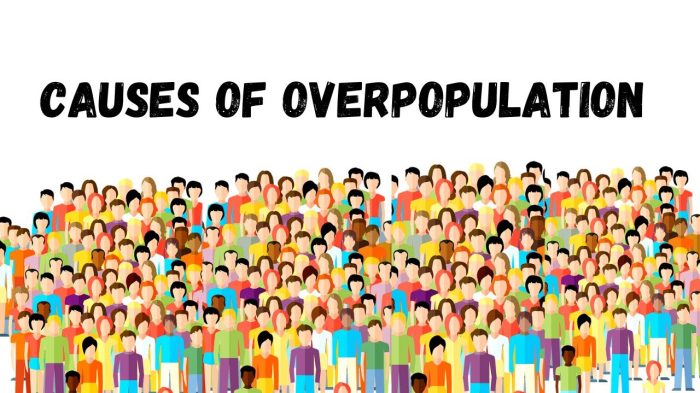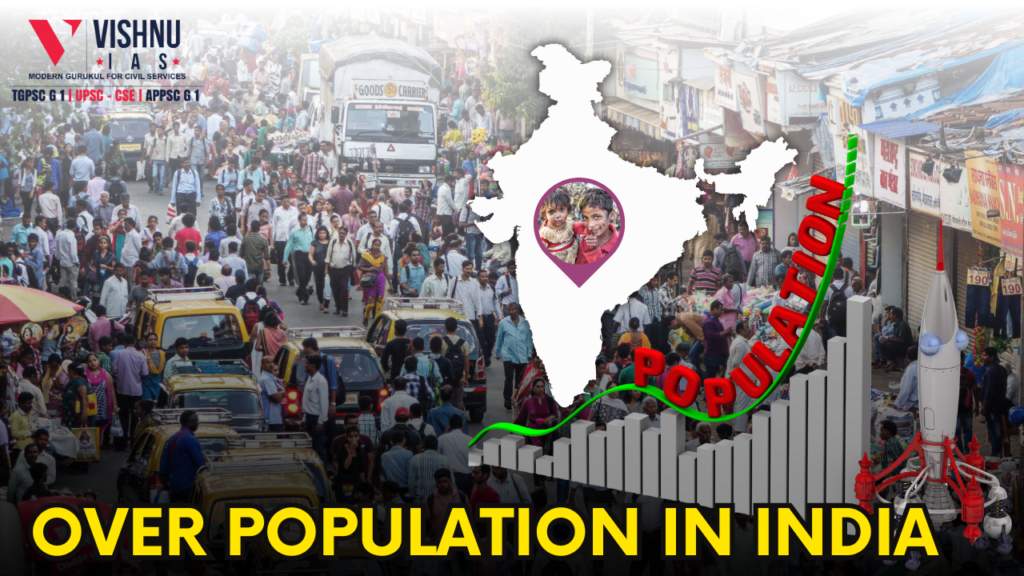OVER POPULATION IN INDIA
India, the world’s second-most populous country, has been grappling with the issue of overpopulation for decades. With a population exceeding 1.4 billion people, India’s population was expected to be bigger than China’s by the middle of 2023 at the latest, according to a UN study. This is the first official confirmation of what has been thought for months. According to the annual State of the World Population report from the UN Population Fund (UNFPA), India will have 1,428 million people by the middle of 2023. India’s demographic dynamics present both significant opportunities and daunting challenges. The phenomenon of overpopulation in India is multifaceted, affecting various aspects of life, including the economy, environment, social structures, and governance.
CAUSES OF OVERPOPULATION IN INDIA

Factors that contribute to overpopulation are many
Socio-cultural factors such as early marriage, near universality of marriage and strong male child preference also lead to more births. Especially in rural areas, early marriages are common. This practice leads to longer reproductive periods and higher fertility rates.Patriarchy and the resultant lack of female sexual and reproductive autonomy too have significantly contributed towards a higher fertility rate. Culturally, children, particularly sons, are considered an asset and a gift of God. Till date, a popular blessing elders shower on a young woman is ‘Doodho nahao, Pooto phalo’ (May you be blessed with riches and many children!) The people who are conservative and orthodox are opposed to the use of family planning measures. Women in such families are not allowed to take part in family planning because they are not supposed to go against the wishes of God. There are also women who argue that children are born with God’s will and women are destined to give birth to children. Surveys among some communities from time to time have found that despite the awareness of modern family planning measures, most respondents, both women and men, are against their use due to religious reasons and fatalistic outlook.
Scientific factors like advances in medical technology and healthcare services have significantly reduced infant mortality and increased life expectancy.Also, better nutrition and medical facilities and since independence has also added to the overall size of the population. While these developments are positive, they also contribute to a growing population.
Socio-economical factors like Lack of Education and Awareness with Limited access to education, particularly for women, correlates with higher birth rates. Education plays a crucial role in understanding family planning and the socio-economic benefits of smaller families. Poverty is both a cause and consequence that is responsible for population growth as it encourages the poor to reproduce more with the expectation that more working hands will mean more family income. Poverty breeds illiteracy and ignorance about family planning. Poverty also compels families to marry their daughters young, resulting in higher fertility rates. Large population is responsible for poverty as for the family, more children means less expenditure per child on his health and education, more family expenses and less savings, and division of agricultural land into unviable landholdings. At a national level, overpopulation leads to underemployment, unemployment and low per capita income. Interestingly, our decadal population growth rate is modest. The problem of overpopulation can then be explained by the fact that we had a large population base to begin with. In other words, we are the largest population in the world because we have always been one of the largest populations in the world!
CONSEQUENCES OF OVERPOPULATION:

The consequences of overpopulation in India are extensive and profound.Overpopulation is an underlying cause for numerous other social problems. Overpopulation has also significant consequences for the national economy.
Economic consequences:
Overpopulation exerts immense pressure on the economy. With a large portion of the population dependent on agriculture and informal sectors, job creation becomes a significant challenge. High population growth also strains public services and infrastructure. It puts an immense strain on the nation’s infrastructure. No matter how much governments attempt to; they are unable to sufficiently provide for the teeming millions. Whether it is shortage of housing, schools and health infrastructure or the overcrowding in public transport; all of these can be traced to overpopulation. This, in turn, can lead to a crisis of governance amid citizens’ unfulfilled aspirations.
Social consequences:
A large population can also be socially disruptive. It can lead to the deepening of social cleavages and foment social conflicts. For instance, it leads to the development of slums in urban areas where the residents lead a sub-human existence. It may induce a sense of relative deprivation amongst the disprivileged; resulting in crime, protests and social movements with people taking resort to naxalism and terrorism. In addition, other social issues that are exacerbated by overpopulation are poverty, malnutrition, inadequate healthcare,lack of access to quality education and heightened competition for limited resources.The healthcare system is overwhelmed by the sheer number of people requiring medical attention. This leads to inadequate healthcare services, long waiting times, and insufficient resources to handle public health crises. Overpopulation may also attribute to the attribute the low labour force participation of women to gender discrimination in terms of wages and opportunities.
Environmental consequences:
A large population is also responsible for environmental pollution, deforestation and ecological degradation.Overpopulation contributes to environmental problems such as deforestation, loss of biodiversity, pollution, and increased carbon emissions with the demands for land, water, and other natural resources exceeding sustainable levels. When the burden of population in any area becomes imbalanced compared to the available financial resources, people tend to move away from their original location. It is comparable to the phenomenon of bee hive – when it is completely filled, flies leave it and go elsewhere. Similarly, human beings stop at one place for a time and then feel the urge to move on again. For this reason, human beings generally do not live anywhere permanently except for a few exception
POPULATION NOT JUST A BANE BUT BOON:

Nevertheless,a strange, even tragic, predicament faces the world. While one part of the planet is dealing with a growing population that needs food, jobs, education, and healthcare, the other is grappling with a declining population. Recently, Japan’s Prime Minister Fumio Kishida made a “now or never” appeal to the people of Japan, exhorting them to have more children. Similar trends have been reported in several other countries around the world.
Demographers claim that population is not a burden in and of itself. Instead, what decides whether a population is a “resource” or a “burden” is its rate of growth, size, and diversity. As long as the country’s carrying capacity remains unharmed, the population is a resource. As the country with the biggest population in the world, there are advantages and disadvantages. So, if one looks at only the total population size, which is often assumed to be the number of mouths to feed, it is grossly misleading. The age composition of the population is a crucial factor to consider as it sheds light on the available support ratios. This ratio is determined by the number of individuals within the working age population (15-64 years) in comparison to those within the dependent population (0-14 years and 65 years and above).India’s population is often younger, offering higher support ratios, and there are fewer illnesses, disabilities, and caregiving responsibilities. The opportunity for India must be compared to the effects of population decrease and aging in various nations, including those with large economies like China, Japan, and the United States. To increase birth rates, the bulk of them have been enacting pro-natalist legislation. These efforts, however, have mainly proven fruitless. Once fertility starts to fall, it is challenging to turn it around.
There is a significant demographic opportunity that could have a major impact on per capita GDP in the coming decades. Specifically, if the working age population continues to grow at its current rate, there is the potential for a 43% increase in per capita GDP by the year 2061 as per the UN report. However, this growth is contingent on a supportive socio-economic and political environment.
India may face economic challenges if its total fertility rate falls below 1.8, according to experts. Drastic population control measures could potentially lead to forced population aging, causing the nation to “age before prospering”. Invisible and unsustainable production, consumption, and unequal distribution are posing a greater threat than climate change and economic harm. These factors are causing significant damage, surpassing the impact of visible population size.
According to 2007 study of Nicholas Eberstadt titled ‘Too Many People?’ has revealed that there is no apparent link between poverty and population density. Despite the expectation that high population density leads to increased competition for resources, Monaco, a country with 40 times the population density of Bangladesh, is thriving. Bahrain, with a population density three times that of India, is noteworthy. Contrary to popular belief, population growth does not lead to poverty. In fact, it can actually contribute to greater prosperity
According to economist Julian Simon’s 1981 publication, there is a correlation between population growth and productivity throughout history. Simon observed that whenever there has been a surge in population, there has also been a corresponding increase in productivity.
Economically,A large population also means a large and cheap labor force, necessary to fuel economic growth.A large population also means a huge market for various products and services, from mobiles to two-wheelers and FMCG products. This means that Indian firms can always access the huge domestic market, even if other economies hit a recession. It also makes India an attractive investment destination for global investors and attracts muchneeded FDI. Given the large market size, firms can achieve economies of scale. Having the world’s largest population also provides a psychological edge to the citizenry and national leadership alike. It affords us an opportunity to have a huge standing army, crucial for national security. For instance, it is reassuring that we have a standing army three times the size of Pakistan’s army
SOLUTIONS TO REAP THE BENEFITS OF DEMOGRAPHIC DIVIDEND:
Now,The country is in need of policies that foster a conducive environment for the provision of top-notch education, quality healthcare, decent job opportunities, reliable infrastructure, and gender empowerment. India’s “demographic burden” could turn into a “demographic dividend” if the country addresses the issue of overpopulation in India in a multifaceted approach.
Educational sector:
Enhancing access to education, particularly for women, is crucial. Educated individuals are more likely to understand and implement family planning measures. Comprehensive sex education and awareness campaigns can also play a vital role in changing societal attitudes towards family size.Empowering women through education, employment, and legal rights is fundamental.
Health sector:
In addition,Expanding the availability and accessibility of family planning services is essential. Government and non-governmental organizations should work together to provide affordable contraceptives and educate people about their benefits.Effective government policies Policies should be inclusive, respecting cultural and religious sensitivities while promoting sustainable practices. In health scenario,Strengthening the healthcare system to reduce infant and maternal mortality rates can contribute to smaller family sizes. Ensuring access to quality healthcare and nutrition is vital for population control.
Economic support:
Also,Improving economic conditions can reduce the perceived need for larger families. Developing rural areas to provide better employment opportunities, education, and healthcare can reduce migration to urban centers and help balance population distribution.Job creation, especially in the formal sector, and poverty alleviation programs can help stabilize population growth.
Policy inititativinitiativeses:
Most importantly.The delay in completing the 2021 Census could had damaging implications for a variety of sectors, and could potentially impact India’s growth prospects as well. The Census exercise produces basic input data for all sorts of indicators used for planning and policy implementation. These indicators are also used for investment and trade decisions by global partners. In the absence of reliable indicators, based on solid numbers from the Census, the quality of these decisions could suffer.
Interntional collabaration:
Finally, Concrete steps need to be taken on a national and international levels to combat the adverse effects of overpopulation, so that sustainability of natural resources can be ensured for future generations.
CONCLUSION:
Looking at the population composition of India, there are greater prospects for a demographic dividend than a burden. According to recent data from UN report, the country is set to benefit from a demographic window of opportunity for the next 35 years, with around 65% of the working age population projected . This presents a significant economic dividend for the nation. While a demographic window of opportunity may exist, it does not guarantee an economic dividend. The imperative for the country is to focus on the essential mechanisms that convert a demographic surplus into a financial benefit. So,Overpopulation in India is a complex issue which requires comprehensive and sustained efforts to address. By focusing on education, healthcare, economic development, and effective governance, India can work towards stabilizing its population growth. The challenges posed by overpopulation are significant, but with concerted efforts and innovative solutions, India can harness its demographic potential for sustainable development and improved quality of life for its citizens.


